Introduction
Cows are members of the Bovidae family, which includes antelope, goats, sheep, bison and buffalo. Modern domestic cattle (Bos taurus) descend from the much larger, now extinct aurochs which once ranged throughout Africa, the Middle East, India, central Asia and Europe. Today, cows across the globe are farmed for beef, milk and leather.
Fascinating facts
Large and long-lived

Depending on the breed, cows can weigh between 80 and 280 stone (500 to 1,800 kg), with males (bulls) being bigger than females.1https://www.britannica.com/animal/cow When they’re allowed to live out their natural lifespan, cattle can live for 20 years and some, at sanctuaries, have lived into their 30s.
Cows don’t just eat grass
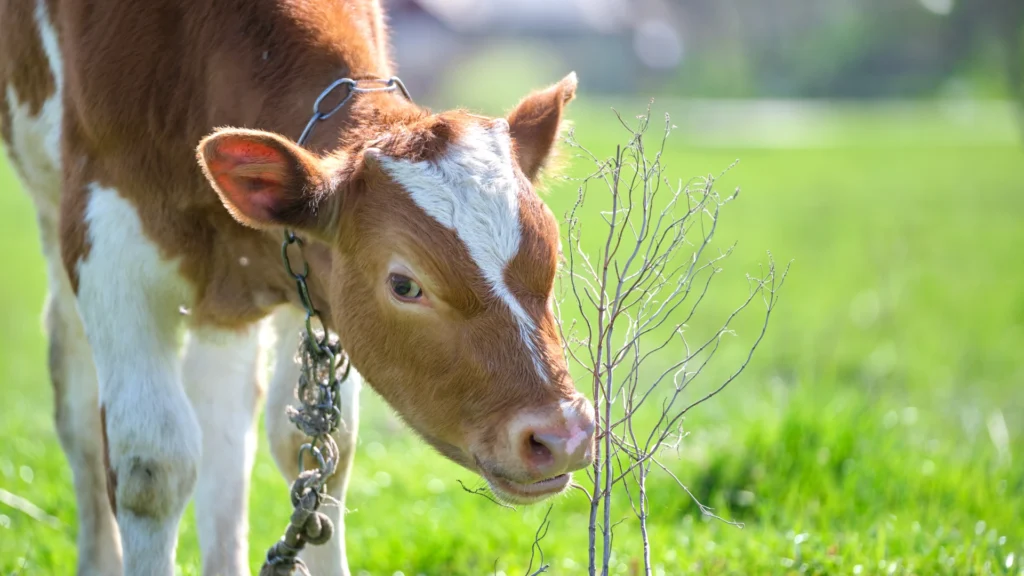
Contrary to the popular belief that cows just eat grass, they like a mixed diet. Just as people like different foods for breakfast and dinner, cattle prefer clover in the morning and grass in the evening. But if they could just choose one, they’d pick clover over grass.2https://www.sciencedirect.com/science/article/pii/S0022030204732816
Cows love games and puzzles
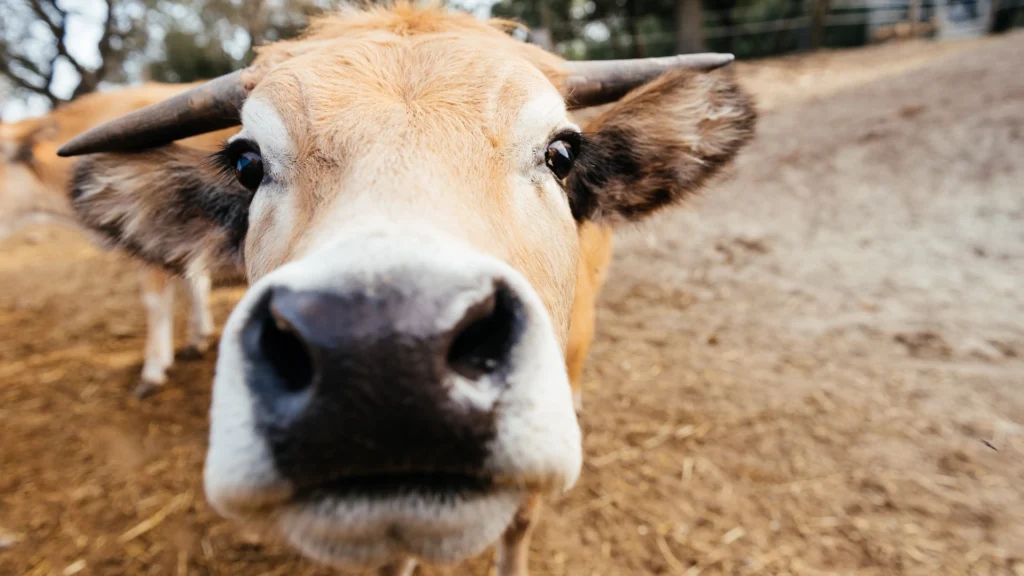
Cows have been known to play hide-and-seek, although they’re a bit too big to be very good at the game! Cows also like to problem-solve and can get excited when they find solutions.3https://www.theguardian.com/environment/2017/oct/30/secret-life-of-cows-loving-intelligent-kind-eat-them Cows are much cleverer than you think!
Cows have tight families and lifelong friendships
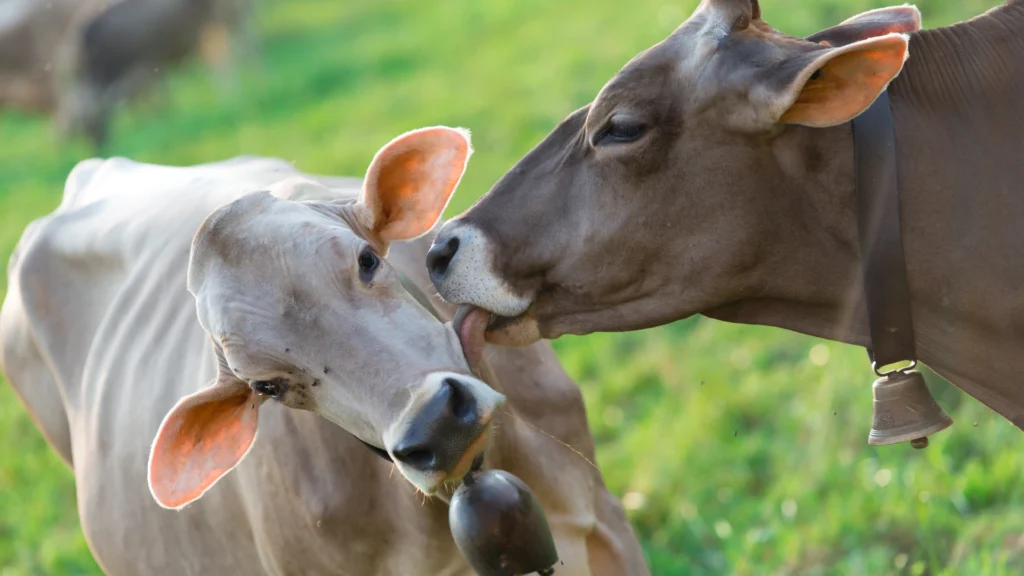
Within herds, the social structure is based on matriarchal families; mother cows and their daughters remain grooming and grazing partners for life and have very strong bonds with each other. Cows also form lifelong friendships with other cows to form a herd and calves befriend other calves for the rest of their lives.4Sowell BF, Mosley JC and Bowman JGP. 1991. Social behavior of grazing beef cattle: Implications for management. The American Society of Animal Science 77, 1-6.
Cows are extremely protective and caring of their offspring
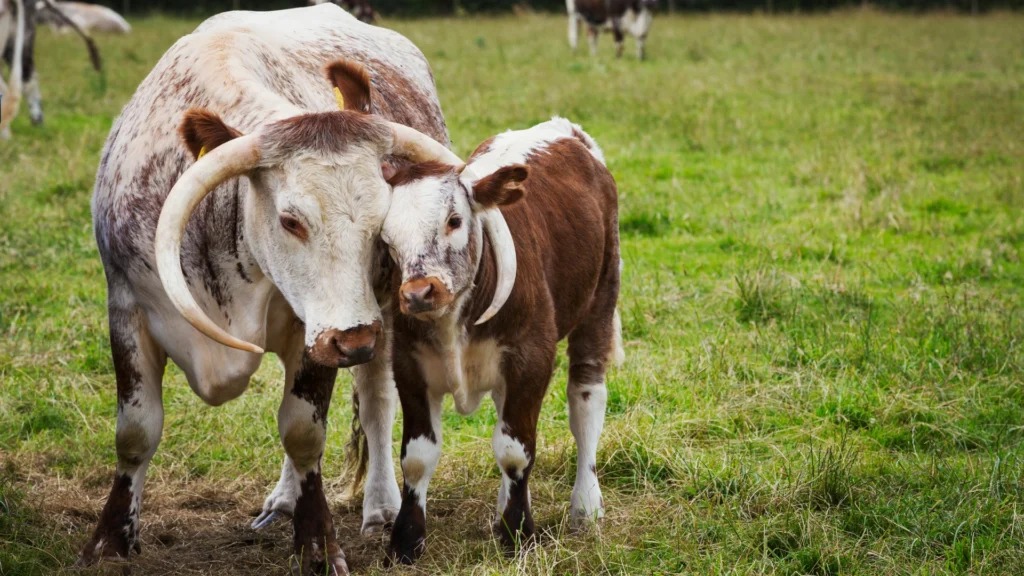
Mother cows give birth in private and hide the calf in long grass out of sight for about a week before introducing the newborn to the rest of the herd.4Sowell BF, Mosley JC and Bowman JGP. 1991. Social behavior of grazing beef cattle: Implications for management. The American Society of Animal Science 77, 1-6. The herd approves the new member who then joins them. Female calves suckle from their mother for nine months and then stay together for the rest of their lives. Male calves suckle for about a year and then leave to join a bachelor herd.
Cows are emotional animals
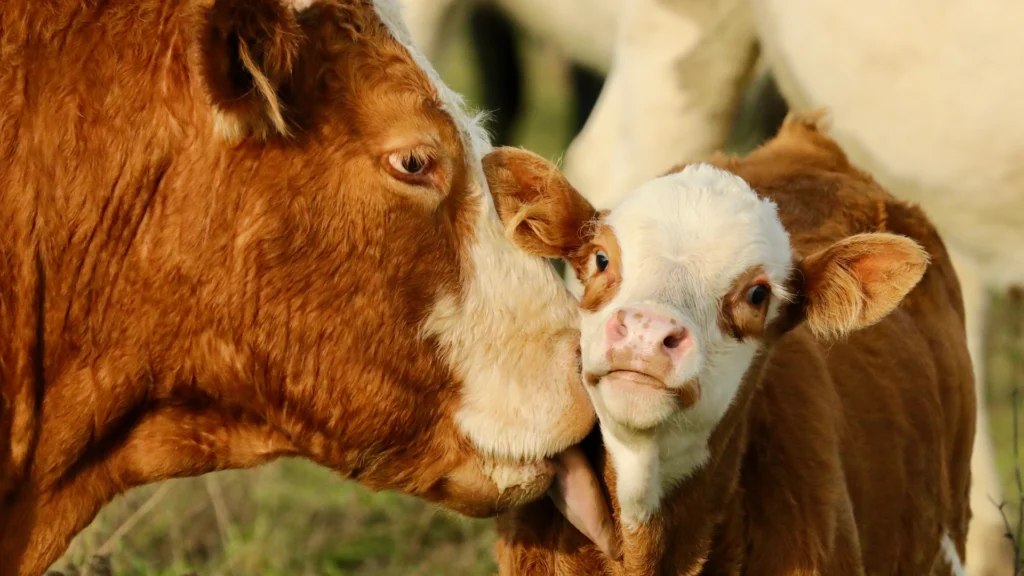
Herds like stability; any disruption to the group, such as the addition of a new member or the removal of another, can be very stressful.4Sowell BF, Mosley JC and Bowman JGP. 1991. Social behavior of grazing beef cattle: Implications for management. The American Society of Animal Science 77, 1-6. Cows grieve for calves they lose and can also feel depression and anxiety. For example, calves kept in isolation hutches – a standard practice in the dairy industry – show clear signs of depression, just like how solitary confinement affects humans negatively.5https://doi.org/10.1371/journal.pone.0090205
Cows are clever communicators
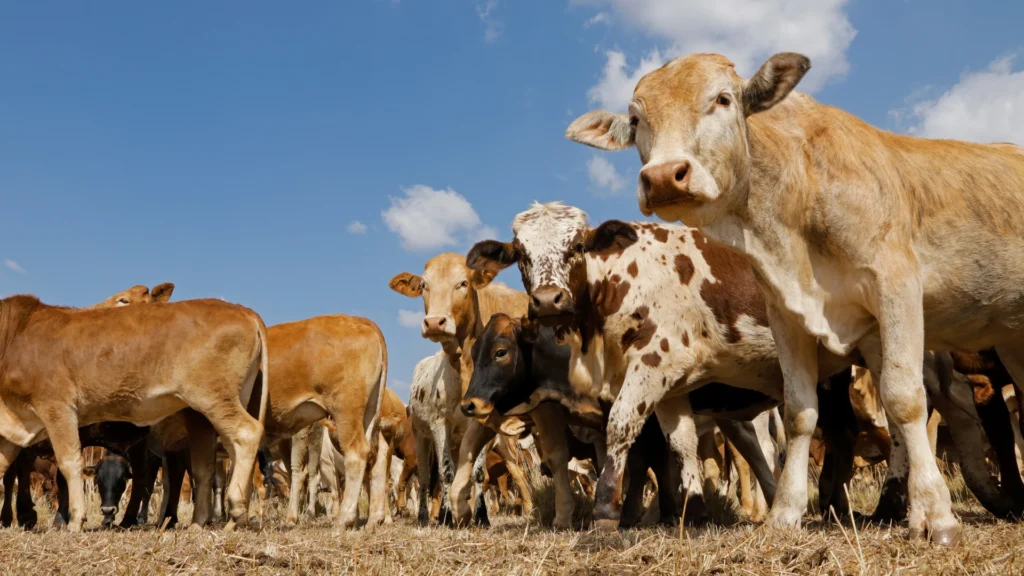
Cows make different noises to address different cows in the herd, just like people use different names for different individuals.6https://www.telegraph.co.uk/news/newstopics/howaboutthat/11297269/Cows-communicate-using-individual-sounds-like-human-names.html They recognise different people and will pretend that they haven’t been fed in order to get second helpings!3https://www.theguardian.com/environment/2017/oct/30/secret-life-of-cows-loving-intelligent-kind-eat-them
Cows can self-medicate
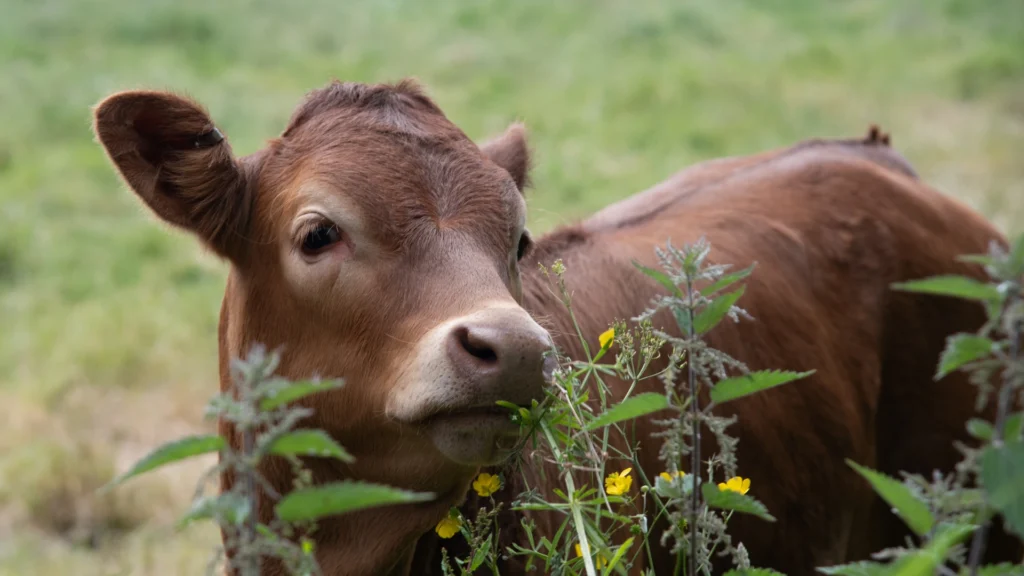
When they feel ill, cows choose to eat certain plants to help them feel better; similar to people eating more fruit or hot soup when feeling sick!3https://www.theguardian.com/environment/2017/oct/30/secret-life-of-cows-loving-intelligent-kind-eat-them The great apes, such as chimpanzees and gorillas do this too, so a cow’s understanding of the natural world is very sophisticated.
Dairy cows in Uganda
There are an estimated 14.7 million dairy cows in Uganda, a number that trebled between 2000 and 20167https://akademiya2063.org/publications/mamo/EN/Meat%20Milk%20and%20More/Meat_Milk_and_More_Uganda_Case_Study_2020_ENG.pdf, each producing around 27 litres a day after giving birth (nearly 500 litres of milk per lactation).8https://smujo.id/aja/article/view/10629/5872 The main breeds of cows milked are Friesian, Ayrshire, Jersey and Guernsey, alongside a small number of local breeds.9https://www.researchtecglobal.com/report/dairy-industry-in-uganda-2022-2023
Dairy farming is becoming a big business in Uganda. Between 2018 and 2020, Uganda’s milk exports grew by 63 per cent according to the United Nations.10https://openknowledge.fao.org/items/c1228252-e246-4887-87a7-5bbd7f1da13e In 2021, Uganda was producing an estimated 2.8 billion litres of milk annually10https://openknowledge.fao.org/items/c1228252-e246-4887-87a7-5bbd7f1da13e, and it was reported that this rose to 3.85 billion litres in 2023.11https://www.independent.co.ug/uganda-milk-exports-double/ In 2022, 1,207,111 cows were killed in Uganda.12https://www.fao.org/faostat/en/#home
How dairy cows are farmed
To produce milk, a cow first needs to be made pregnant, just like people, and must give birth to produce milk.
Before the 1980s, there were two different systems for dairy farming. Southwest Uganda had a few large, government-run dairy farms containing exotic (Friesian) and crossbred dairy cows on pastures. In the drier east and northeast of Uganda, local breeds were farmed in an ‘extensive’ system. Most milk was consumed on a subsistence basis, with little being marketed or exported. This all changed in 1986 when the government introduced ‘zero grazing’ farming to Uganda and started pushing for much higher production. Unfortunately, zero grazing is a cruel system where the cows are never let out to graze, but spend their entire life locked in stalls.
Today, dairy cows are still mainly kept on smallholder farms but there are five major dairy companies operating in Uganda, and this number is set to increase.9https://www.researchtecglobal.com/report/dairy-industry-in-uganda-2022-2023 The average number of cows on a dairy farm is about 80, but depending on the size of the farm this could be anywhere between 19 and 450. Of these cows, around 30 per cent of them are milked at any one time.8https://smujo.id/aja/article/view/10629/5872
In Uganda, dairy cows are farmed in three different ways: extensive, semi-intensive, and intensive.
Extensive
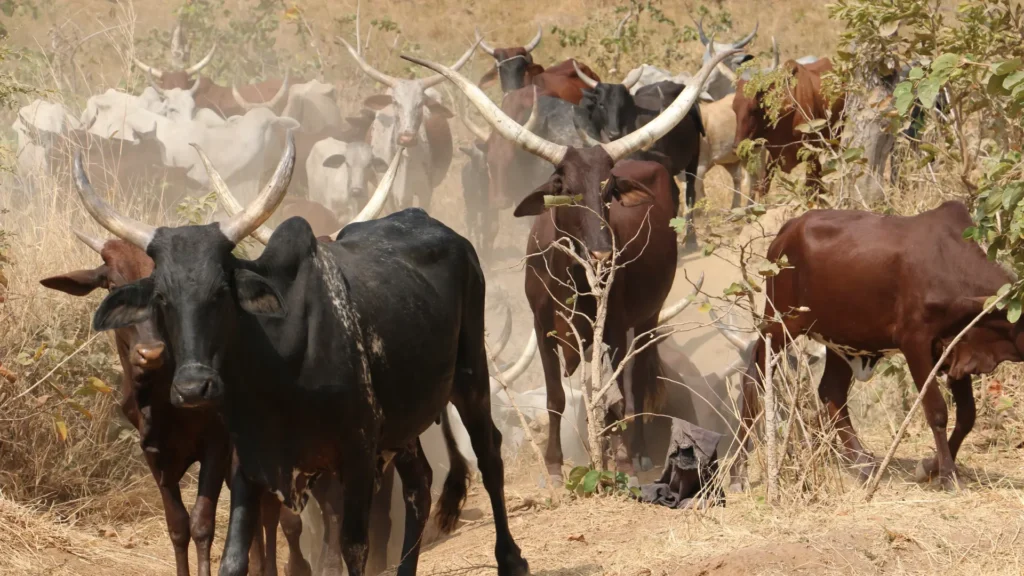
Extensive dairy farming in Uganda requires a lot of land for the cows to graze and was once the most common method amongst smallholder farmers. It usually involves local breeds of dairy cows which are allowed to roam and graze an average of 177 acres.8https://smujo.id/aja/article/view/10629/5872
Although the traditional extensive systems are considered more ‘natural’ than intensive ones, there is nothing natural about them and they still pose serious welfare concerns for the cows.13https://www.frontiersin.org/articles/10.3389/fsufs.2020.545902/full Firstly, these farms rely on natural rain-fed pastures to feed the cows, so the cows suffer from severe undernourishment and dehydration during the dry season and droughts.8https://smujo.id/aja/article/view/10629/5872 In an extensive system, there is much less input from the farmer, including veterinary care. If an animal picks up an infection or parasite, he or she is much more likely to go untreated, suffer painfully and infect the other members of the herd. It is also much harder to supervise cows in an extensive system and they often fall victim to predators. The mortality rate of newborn calves is inexcusably high, being killed by predators, infections and complications during birth.
Intensive
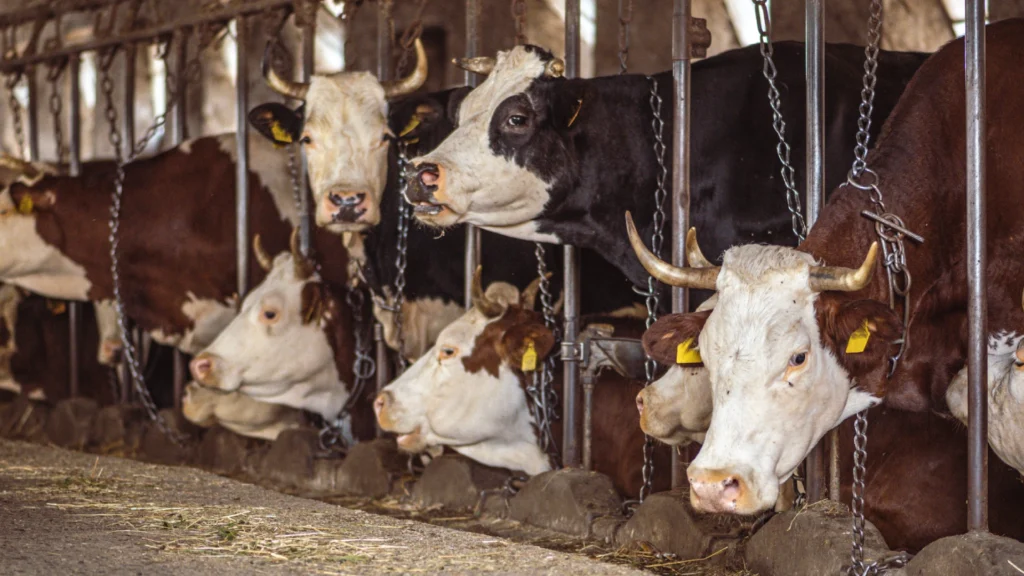
Many smallholder farmers are adopting intensive dairy farming, swapping local breeds for ‘exotic’ breeds (Friesian, Ayrshire, Jersey and Guernsey), and farming them more intensely to squeeze every last drop of milk from their udders.14https://ageconsearch.umn.edu/record/150231/?ln=en
Through selective breeding, the average amount of milk a dairy cow is forced to produce has increased dramatically by about 20 per cent in the last 20 years. The huge increase is causing the many welfare problems. It has inflicted a huge strain on cows, leading to body breakdown. The problem is made worse by milking the cows for most of their pregnancy. This means the cow has the double burden of producing more milk than is natural to her and nurturing a growing calf inside her. The amount and quality of the feed she is given makes it impossible for her to stay healthy. Most dairy cows in intensive systems suffer from metabolic starvation – they become emaciated as their body tissue wastes because it is impossible to eat enough to nurture themselves, their baby and produce unnaturally high quantities of milk. It is very common to see the cow’s bones and spine protruding through her skin.
Intensive farming heavily relies on the grotesque zero grazing method, and this now supplies a significant share of Uganda’s milk production.15https://ebrary.ifpri.org/utils/getfile/collection/p15738coll2/id/128031/filename/128242.pdf Zero grazing farming is heavily marketed as a ‘get rich quick’ scheme for Ugandans struggling to make ends meet. As a result, many Ugandans who have no animal husbandry experience are attempting to farm dairy cows. This can be expensive for the farmers as they lose livestock due to poor animal husbandry, and even more expensive for the cows who lose their lives.
In the zero grazing system, cows are permanently imprisoned in stalls, never feeling the grass beneath their hooves or the sun on their back. They cannot even turn their head to groom their back or side. The sick reasoning is that any energy the cow would have used for movement gets diverted into milk production. It is a prime example of a sentient, feeling, thinking animal being used as a machine.
Keeping cows in zero grazing stalls deprives the cow of her natural environment, restricts her ability to act naturally and increases the risk of many illnesses and disease. It also increases depression. Zero grazing causes lameness and hoof disorders; it causes the cow frustration, pain and discomfort from not being able to move and rest properly; she is unable to perform comfort behaviour such as self-grooming, and it causes metabolic disorders.16https://efsa.onlinelibrary.wiley.com/doi/epdf/10.2903/j.efsa.2023.7993 The fact that this highly exploitative method of farming is being so enthusiastically promoted and adopted across Uganda is massively worrying for the welfare of the cow.
Semi-intensive
Semi-intensive farming combines elements of extensive farming with intensive farming. Many farmers who might have been pressured into intensive farming but weren’t happy with the method, compromised with a semi-intensive system instead.17https://orgprints.org/id/eprint/15549/1/15549.pdf The farming is intensified by using the main breeds of dairy cows and obtaining more milk from them than in an extensive system. The cows are sometimes allowed to graze on pasture in fenced paddocks but are sometimes confined to stalls.8https://smujo.id/aja/article/view/10629/5872 The cows in this system are exposed to both the parasites and dangers of the extensive system, while also spending half of their life confined in stalls, unable to move.
Diseases
Mastitis
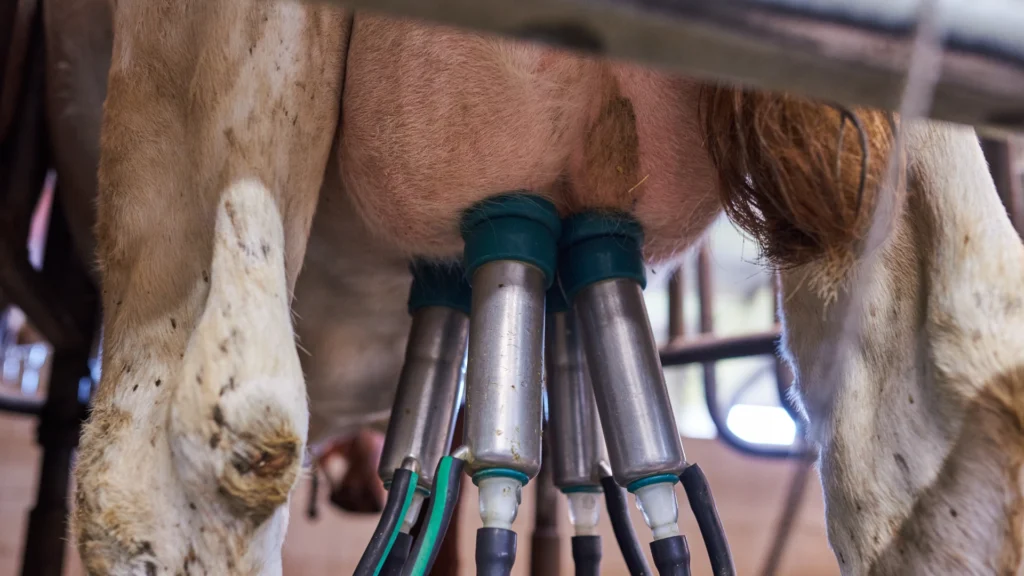
Mastitis is a painful infection of the udders, which can be caused by many types of bacteria entering the teat. The bacteria produce poisons which damage the udders. The cow’s body fights the infection with her white blood cells and when they kill the bacteria, the resulting pus is excreted through the teat. This means that all milk from commercial farms contains pus. Many countries try to stop milk being sold with really high amounts, the EU limits pus cell count in milk to 400 million pus cells per litre. It means that all milk around the world contains pus.
Mastitis is widespread in zero grazing and free range systems where breeds such as Friesians are used. They are bred to produce unnaturally high amounts of milks which leads to the cells inside the teats breaking down, allowing bacteria to invade. On top of that, intensive indoor systems may keep cows in dirty conditions where they cannot exercise – this also lets to more infections.
Lameness
Lameness is a serious welfare problem in dairy cows. It can cause constant pain to the degree that cows feed less, it reduces fertility and a high percentage are killed. The common causes of lameness are poor quality floors, cows being forced to stand too long in indoor systems, poor hoof trimming, dirty conditions where bacteria spread, infectious diseases and poor feed so that the cows are malnourished and cannot fight infections. Also, abnormally large udders push the cow’s hind legs apart, forcing her to walk abnormally putting extra pressure on her outer hooves, causing pain and lameness.
Artificial insemination
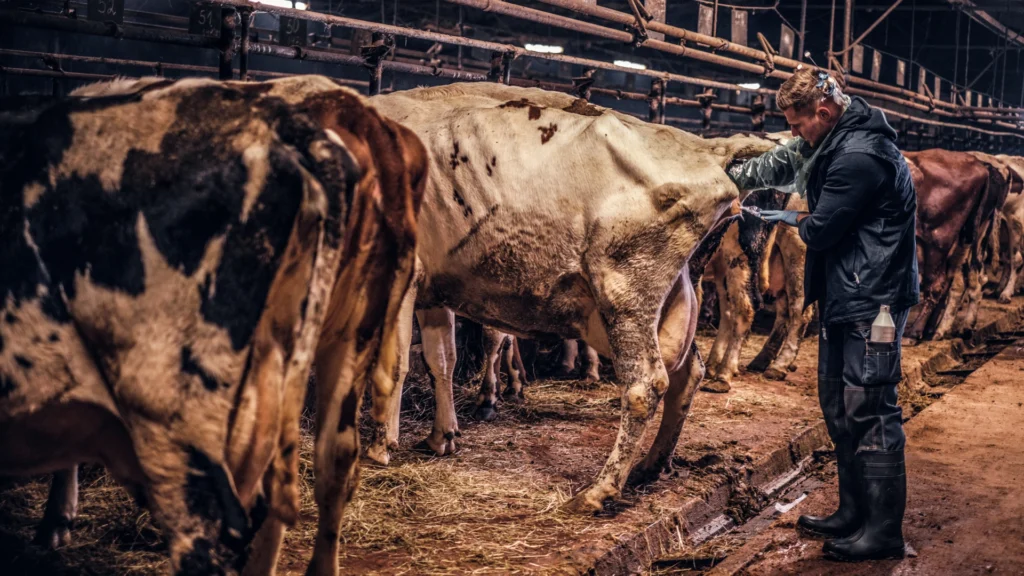
Dairy cows are usually bred by artificial insemination.18https://www.monitor.co.ug/uganda/magazines/farming/quick-guide-to-set-up-a-cattle-farm-1754392 The process is painful and traumatic for cows, who are forced into confined spaces to be impregnated. The farmer inserts one arm into the cow’s anus to manipulate her reproductive organs while an artificial insemination gun is inserted into her vagina to deposit semen.19https://www.youtube.com/watch?v=IJsQvSxmicc This highly unnatural way of impregnation causes cows distress, particularly as any mishandling of her organs can lead to severe pain and nerve damage. Inexperienced farmers practise on live animals and this inevitably leads to injuries.
What about the calves?
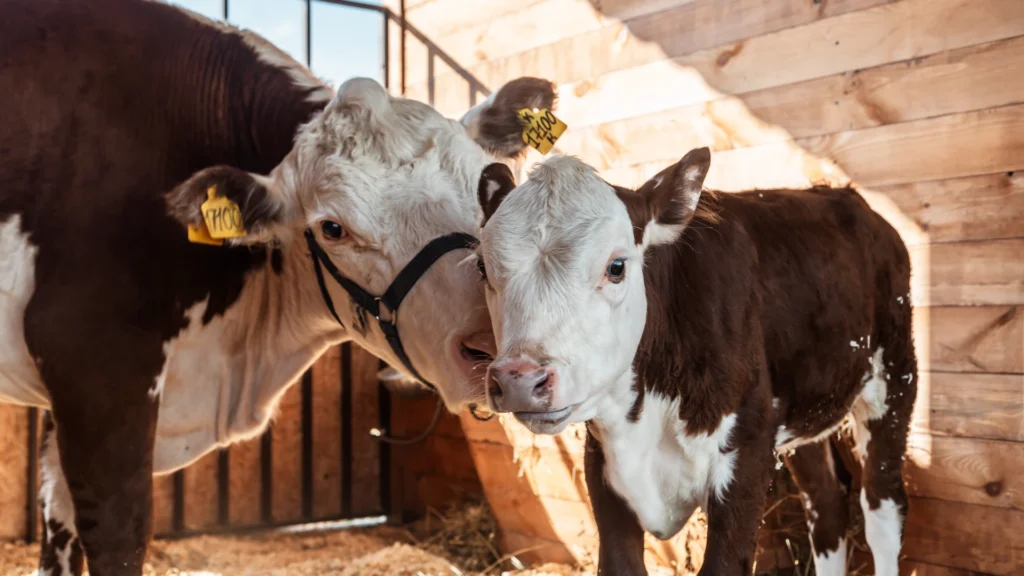
A cow only produces milk when she has given birth to a calf. So what happens to the calf if their milk is being taken for humans?
It is commonplace in the UK, Europe and the US for the calf to be immediately removed from their mother and fed milk formula so that the mother’s milk can be taken for humans. If the calf is male, he is either killed at birth or for beef when they are just one or two years old. If the calf is female, she will be used to replace worn out cows in the dairy herd.
The situation is very similar in Uganda except calves may sometimes be allowed to suckle from their mother. One method used, called “single suckling” involves taking the calf from their mother but allowing them to suckle just once a day, usually after milking. However, usually the bond between mother and calf is completely broken and the most common method used is bucket feeding. The calf is torn from their mother and taught to drink from a bucket, with a human’s finger mimicking the mother’s teat.20https://www.monitor.co.ug/uganda/magazines/farming/caring-for-calves–3393072 Many farms also use bottle feeding but this is a highly dangerous method as milk can get into the calf’s trachea and lungs leading to pneumonia and often death.20https://www.monitor.co.ug/uganda/magazines/farming/caring-for-calves–3393072
In Uganda, male calves are not usually killed at birth. Instead they are either sold to a beef farmer to be raised for meat, kept by the farmer as breeding stock, or put to work in the fields as an oxen.21https://novafrica.org/wp-content/uploads/2019/05/Cattle_DID.pdf
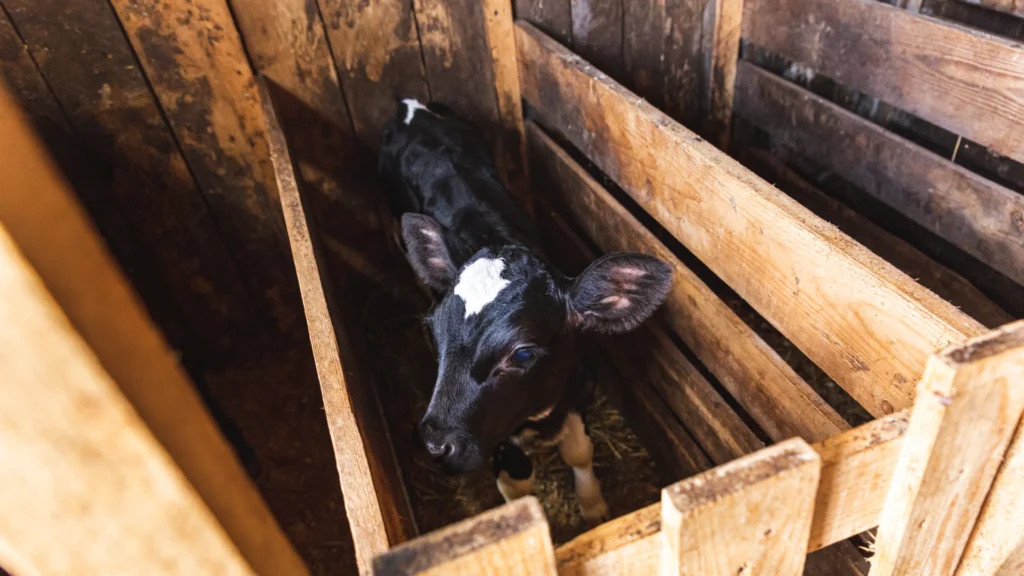
Castration
Not only do male calves have the trauma of being separated from their mother, but they also have to face the pain of castration at a very early age. An excruciatingly tight rubber ring is stretched open with pliers and placed over the base of the calf’s scrotum. This cuts off blood flow to the calf’s testicles so they wither and die, and after around two weeks they drop off. Another method of castration is known as an “open castration” where the calf’s scrotum is sliced open with a knife, his testicles pulled out and sliced off from the attached ligaments. The wound is left open to heal by itself. The poor calf receives no pain relief for these painful procedures. For dairy calves, their first experience of life is pain. Many smallholder dairy farmers have no prior experience with animals and are bound to make mistakes which cost the animals dearly.
Housing
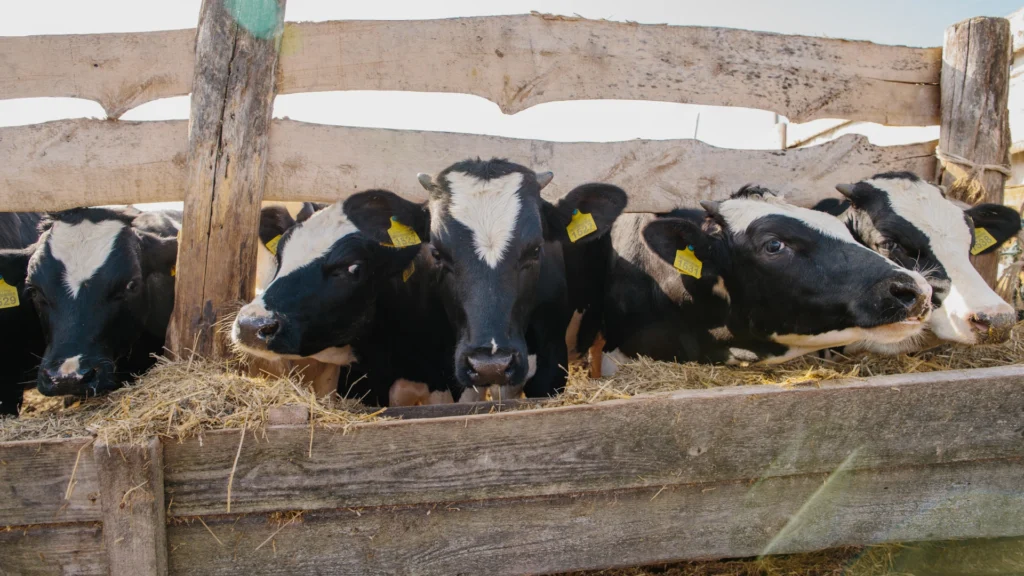
Poor housing for the calves causes deaths on many farms.20https://www.monitor.co.ug/uganda/magazines/farming/caring-for-calves–3393072 A 2021 survey of Ugandan farmers revealed that although 70 per cent of farmers provide shelter for calves, over half of them didn’t think the shelters would successfully protect the calves.22https://www.sciencedirect.com/science/article/pii/S2468227621001095 And in some regions less than 40 per cent of smallholder farmers provide any housing for the calves.22https://www.sciencedirect.com/science/article/pii/S2468227621001095
Improper housing for calves leads to many problems. They are often exposed to extreme temperatures, wind and rain. If they are kept in makeshift mud structures, they are usually full of dust in the dry season and damp mud in the wet season. Being located close to the main cow shed also exposes them to disease and infections before they are strong enough to fight them off. Calves are prone to health complications such as pneumonia and several bacterial infections – and many do not survive.20https://www.monitor.co.ug/uganda/magazines/farming/caring-for-calves–3393072
The bond between mother and child is sacred, and this is no different for cow and calf. The fact that the dairy industry can only exist by breaking and exploiting this sacred bond is proof that dairy farming does not belong in a modern, compassionate society.
References
References
- 1
- 2
- 3
- 4Sowell BF, Mosley JC and Bowman JGP. 1991. Social behavior of grazing beef cattle: Implications for management. The American Society of Animal Science 77, 1-6.
- 5
- 6
- 7
- 8
- 9
- 10
- 11
- 12
- 13
- 14
- 15
- 16
- 17
- 18
- 19
- 20
- 21
- 22

